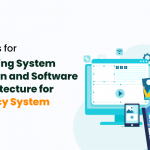15 Best Practices For Modern Software Architecture Design

Software architecture makes or breaks your software’s success, and that’s why following software architecture design best practices have become an SOP for most teams.
“Consider thinking of architectural decisions as investments and take into account the associated rate of return, it is a useful approach for finding out how pragmatic or fit for purpose every option on the table is,” remarks Richard Monson-Haefel in his 97 Things Every Software Architect Should Know.
Monson-Haefel’s views are important for building sustainable software lies in its architectural foundation. A well-designed software architecture is the cornerstone of the long-term productivity of a software system. It guides development team members with a roadmap, handles any possible vulnerability, and assists in iterative development.
In today’s time when software works on distributed systems and has to offer automation functionalities, the evolving considerations in the architecture design process must be given due care. To work against these requirements, optimize the development process, and build a scalable system, you need to arm yourself with software architecture best practices.
So, what are the best principles for software architecture? What to be careful of when architecting a software? and what are the mistakes software architects make?
We will cover that all. Let’s dive in-
Best practices and principles for software architecture
The best practices discussed below might look similar but they are distinct in nature. You cannot turn a blind eye to any of them when designing a software architecture.
Give attention to both functional and non-functional requirements
As with any architectural choice, its adoption should be driven by specific project requirements and trade-offs, which is where the need to assess functional and non-functional requirements arises.
Functional requirements dictate what the system should do, encompass features and capabilities, and guide the design and development process. It makes the software align with business objectives and end-user needs. Non-functional requirements, on the other hand, encompass qualities like performance, scalability, security, and maintainability.
A balanced consideration of both types while designing the architecture equips software to not only deliver desired functionalities but also meet critical performance benchmarks. So, effectively you align your design and development efforts with the broader business objectives.
Adopt a Zero-Trust approach with different zones
The significance of Zero Trust Architecture lies in its ability to significantly enhance security in modern, distributed computing environments. Traditional perimeter-based security models are no longer sufficient in a landscape where cloud services, mobile devices, and remote work are commonplace.
With the Zero Trust, even if attackers gain access to one part of the system, they need authentication and authorization to access other sensitive resources. Complement it with Zone segmentation, where each security zone has its own security controls and access policies.
Use a modular architecture
As a first step, start by breaking down a software project into discrete, independent modules or components, each responsible for a specific functionality or feature. Architectural patterns, such as the Model-View-Controller (MVC) or Microservices, often serve as blueprints for implementing modular architectures. We’ll delve into Microservices in detail, later, in a separate section. These patterns guide the arrangement and interaction within the software design.
By compartmentalizing functionality, developers can work on different modules simultaneously, which is important to improve parallelism and speed up development. Next, modularity replaces or upgrades individual modules without disrupting the entire system, promoting agility and adaptability, crucial in dynamic software environments.
Keep it Simple
Software development emphasizes the importance of avoiding unnecessary complexity in the design of a software system. The principle is crucial for various reasons. Firstly, it enables better collaboration within the software development team, as simpler designs are easier to understand and maintain. Additionally, it enhances scalability, allowing the system to handle increased loads without major reengineering.
A simple architecture also helps in smoother deployment, reducing the likelihood of errors or performance issues. It aligns with agile methodology and enables faster iterations and quicker responses to changing requirements. Complex architectures, on the other hand, can lead to confusion, slow down development, and increase risks.
Follow the principle of separation of concerns
As a fundamental best practice, the principle of separation of concerns is a fundamental best practice in the designing of software architecture. For organizing a system into distinct and independent components, you need to make use of this specific aspect of functionality. By following this principle, you can build a maintainable, clear, and understandable structure for the software.
By separating concerns, developers isolate different functionalities, such as user interface, business logic, and data storage, reducing interdependencies between them. Different teams can work on separate concerns simultaneously which aids in parallel development.
Here is an example of how sticking to this principle assists. In a web application, separating concerns would involve distinct layers like the presentation layer for user interface, the business logic layer for handling application-specific tasks, and the data access layer for interacting with databases. This way, changes in one concern have minimal impact on the others, promoting flexibility and scalability.
Consider all performance parameters
The way a software architecture influences performance parameters dictates the long-term efficiency of the software it rests upon. As a result, the following parameters must be given careful thought while designing software architecture:
| Performance Parameter | Description |
| Processing Speed | Optimization of algorithms and code execution to minimize processing time for tasks and operations. |
| Memory Utilization | Efficient management of memory resources, including allocation, deallocation, and minimizing leaks. |
| Network Latency | Minimizing the time it takes for data to travel between components, involving communication protocols. |
| Concurrency and Parallelism | Handling multiple tasks or processes concurrently, making use of available resources like multi-core processors. |
| Throughput | Number of transactions or operations a system can handle within a given time frame. |
| Response Time | Time taken for the system to respond to a request, a crucial metric for user-facing applications. |
| Availability and Reliability | Ensuring that the system remains accessible and dependable, often measured by metrics like uptime and MTBF. |
| Fault Tolerance and Resilience | Designing the architecture to gracefully handle failures and recover from errors without causing disruption. |
| Load Balancing | Distributing workloads evenly across multiple servers or components to prevent overloading. |
| Caching | Utilizing mechanisms to store frequently accessed data or computations, reducing the need for repeated processing. |
| Optimized Data Structures and Algorithms | Choosing appropriate data structures and algorithms for specific tasks to improve computational efficiency. |
Benchmark the system under various loads to identify potential bottlenecks and inefficiencies, and record the performance against these parameters. Through these steps, you will anticipate future growth and make the system accommodative.
Be cautious of scope creep
There is always a possibility that a project’s requirements can expand beyond their original boundaries, often due to evolving client demands or inadequate initial planning. With respect to software architecture, this deviation relates to vigilant monitoring and controlling changes to the project’s specifications or functionalities.
To mitigate scope creep, architects must establish robust requirements documentation, engage in thorough stakeholder communication, and employ change management processes. By regularly reviewing and validating project requirements against the original, they keep check on changes in scope and align alterations with the project’s goals and objectives.
Go with a Microservices Architecture
As we mentioned in the preceding part, a microservice architecture lets you break your application into independently deployable services. Each service is responsible for a specific business capability and communicates with others via APIs or messaging protocols.
Due to this capability, Microservices offer several benefits as the architecture
- Enhances the scalability of the system as each individual service is available to be scaled independently.
- Imparts agility, allowing teams to work on different services concurrently, expediting development, and making the software development lifecycle (SDLC) flexible.
- Improves fault isolation, meaning that if one service fails, it doesn’t necessarily affect the entire system.
- Encourages technology diversity, enabling teams to choose the best tools (tools like Kubernetes, Docker etc.) for each service.
Reminds me when we were hired as a Python development agency to build a marketplace in 2013 or so and the challenges we faced in convincing the customer about the pros of this new architecture. What a great decision that turned out to be!
Adopt a Layered Architecture
In software engineering, you must build distinct, hierarchical layers in your architecture, where each layer represents a specific level of abstraction and functionality, with clear interfaces between them.
The layers typically include presentation, business logic, and data storage, and they perform their functions as:
– The presentation layer handles user interface components and user interaction, sending requests to the business logic layer.
– The business logic layer contains the application’s core functionality and processes requests from the presentation layer, executing tasks like computations.
– The data layer manages data storage, retrieval, and manipulation.
Having different layers makes it easier to debug, test, and update, as changes in one layer do not necessarily affect others.
Decompose by Domain
Each domain represents a specific area of functionality within the system, such as user management or payment processing. Isolate all such domains so that developers can focus on understanding and implementing the unique requirements and constraints of each.
Decomposing by domain reduces complexity and makes code reusable, as components can be shared across different parts of the system or even across projects. All you need to do is establish a robust integration mechanism to bring together these domains into a cohesive, functional system.
Have an Event-Driven Architecture
In an event-driven architecture, components communicate asynchronously through an event bus or broker, and so they operate independently of each other. Publishers generate events, while subscribers listen for specific types of events and respond accordingly. The decoupling of events is essential to achieve resilience in a software application. Effective implementation of event-driven architecture lets you isolate, add, or modify components without disrupting the entire system.
Key components in event-driven architecture include:
Event: It encapsulates relevant information about a specific occurrence.
Event Producer/Publisher: Generates and emits events when a significant action or state change occurs.
Event Consumer/Subscriber: Listens for specific types of events and triggers appropriate actions in response.
Event Broker/Bus: Acts as an intermediary, routing events from publishers to subscribers, ensuring loose coupling between components.
Don’t skip Event Sourcing
Capturing and storing every state change in an application as a distinct immutable event is a challenge. Thanks to Event Sourcing that helps in this regard. Instead of persisting with the current state of an entity, Event Sourcing maintains a historical log of events that led to its current state. Undoubtedly, this mechanism must be carefully considered when building architecture for your software application.
However, Event Sourcing requires careful consideration of event schema evolution and versioning, as well as efficient event storage and retrieval mechanisms. And when thoughtfully implemented, it benefits in many ways, as you prepare your software architecture to offer a robust ecosystem for:
- Complex operations like temporal queries and event replay, allow users to reconstruct past states or project future ones.
- Auditing, temporal analysis, and scalability of state reconstruction.
Implement Smart Endpoints and Dumb Pipes
The system architecture you design must evenly distribute intelligence within the system, for which you need to make the endpoints – components responsible for sending and receiving data –intelligent and capable of handling complex logic. On the other hand, keep the communication channels, or pipes, simple and lightweight.
With this practice, you empower endpoints to make decisions, process data, and perform computations, reducing the burden on the communication infrastructure. By utilizing lightweight communication protocols like HTTP or MQTT, the focus shifts towards efficient data transfer.
The benefit you get in such system architecture design principle is that the system can easily accommodate new endpoints or services without overloading the communication channels. It also enhances flexibility and adaptability, as changes to endpoint logic can be made independently of the communication infrastructure.
Equip for Load Balancing
Distributing incoming network traffic evenly across multiple servers or resources optimizes performance, maximizes resource utilization, and improves resource availability. Load balancing prevents any single server from becoming a bottleneck. The ability to balance loads is one key characteristic of a resilient software architecture.
A good software architect always mulls project-relevant load-balancing techniques to efficiently balance loads. Techniques like DNS-based load balancing distribute traffic by manipulating DNS responses to direct clients to different servers based on factors like geographic location or server availability. Prior to implementing any load balancing techniques, architects will make an assessment of factors such as server health monitoring, session persistence, and the ability to handle dynamic scaling.
Follow the Idempotence Principle
Design your architecture to follow the Idempotence Principle which multiplies operation without changing the result beyond the initial application. In other words, if you perform the same action repeatedly, built on a dynamic architecture the system returns the same outcome as if it were executed just once. In applications that work in a distributed ecosystem, this property becomes particularly important, as operations may be retried due to network failures or other issues.
By adhering to the Idempotence Principle, developers are supported with an architecture to build more robust and reliable systems. It simplifies error handling and recovery strategies and makes the system deal with unpredictable events and failures.
Need help with your software architecture ?
Software architecture is the backbone of any successful software system that you can build by adhering to the best practices we discussed. As said, there’s no reason you can think of avoiding any of them, which actually makes following them a bit tricky.
With experts like Finoit at your disposal, you can eliminate the complexity involved in designing software architecture. Our software agency with expert team will guide you through the process, designing an infallible architecture that will be capable of meeting future needs.


